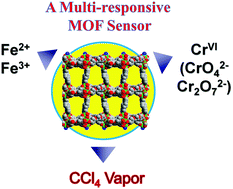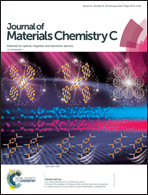Highly selective luminescent sensor for CCl4 vapor and pollutional anions/cations based on a multi-responsive MOF†
Abstract
A porous luminescent cadmium-based metal–organic framework (MOF) with the formula of {Cd3(L)(bbib)·6DMF}n, denoted as NBU-18, was successfully assembled based on the flexible hexacarboxylate ligand H6L (hexa[4-(carboxyphenyl)oxamethyl]-3-oxapentane acid) and rigid N-ligand bbib (1,4-bis(1H-benzo[d]imidazol-1-yl)benzene) with Cd(NO3)2·4H2O under solvothermal conditions. Its structure was identified by single-crystal X-ray diffraction, powder X-ray diffraction, thermogravimetric analysis, and infrared spectroscopy. Single-crystal X-ray study of NBU-18 revealed that the L6− carboxylate ligand as a flexible arm and the bbib ligand as a rigid pillar connected the CdII3 secondary building unit (SBU) into a 2-fold interpenetrated (4,6)-connected fsc three dimensional (3D) net with a large number of open Lewis base sites and large porosity. Remarkably, the porous MOF NBU-18 exhibits high thermal stability up to 400 °C and exceptional chemical stability in various common solvents and aqueous solutions with an extensive pH range of 2–13. Such characteristics render it suitable as a fluorescent sensor. Luminescence investigations reveal that NBU-18 can recognize CCl4 vapor with high selectivity in the presence of other volatile chloromethanes, which is the first example of CCl4 sensing in the vapor phase. Furthermore, NBU-18 as a sensor can also detect pollutional CrO42−/Cr2O72− anions and Fe2+/Fe3+ cations with excellent sensitivity based on a turn-off sensing mechanism. This work paves the way for practical applications of NBU-18 as a sensor.



 Please wait while we load your content...
Please wait while we load your content...